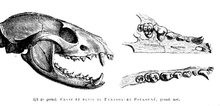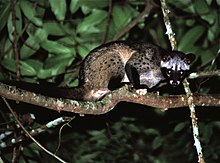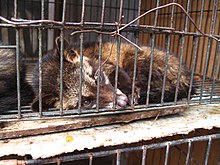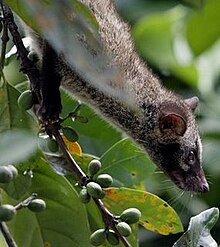Asian palm civet
| Asian palm civet | |
|---|---|

| |
| Scientific classification | |
| Kingdom: | |
| Phylum: | |
| Class: | |
| Order: | |
| Suborder: | |
| Family: | |
| Genus: | |
| Species: | P. hermaphroditus
|
| Binomial name | |
| Paradoxurus hermaphroditus[2] (Pallas, 1777)
| |

| |
| Asian palm civet range: native in green, introduced in red | |
The Asian palm civet (Paradoxurus hermaphroditus) is a small viverrid native to South and Southeast Asia. Since 2008, it is IUCN Red Listed as Least Concern as it is tolerant of a broad range of habitats. It is widely distributed with large populations that in 2008 were thought unlikely to be declining.[1] In 2012, it was suggested that recent increases in capturing the animals for kopi luwak (civet coffee) production may constitute a significant threat to wild palm civet populations.[3]
Characteristics


The Asian palm civet is a small, mottled gray and black viverrid weighing 2 to 5 kg (4.4 to 11.0 lb). It has a body length of about 53 cm (21 in) with a 48 cm (19 in) long tail. Its long, stocky body is covered with coarse, shaggy hair that is usually greyish in color. There is a white mask across the forehead, a small white patch under each eye, a white spot on each side of the nostrils, and a narrow dark line between the eyes. The muzzle, ears, lower legs, and distal half of the tail are black, with three rows of black markings on the body. The tail is without rings, unlike in similar civet species. Anal scent glands emit a nauseating secretion as a chemical defense when threatened or upset.[4] Despite its species name hermaphroditus, the palm civet has two distinct sexes and are not hermaphrodites.
Distribution and habitat
The Asian palm civet is native to India, Nepal, Bangladesh, Bhutan, Myanmar, Sri Lanka, Thailand, Singapore, Peninsular Malaysia, Sabah, Sarawak, Brunei Darussalam, Laos, Cambodia, Vietnam, China, the Philippines, and the Indonesian islands of Sumatra, Java, Kalimantan, Bawean and Siberut. It was introduced to Irian Jaya, the Lesser Sunda Islands, Maluku, Sulawesi and Japan. Its presence in Papua New Guinea is uncertain.[1]
It usually inhabits primary forests, but also occurs at lower densities in secondary and selectively logged forest.[5]
It is also present in parks and suburban gardens with mature fruit trees, fig trees and undisturbed vegetation. Its sharp claws allow climbing of trees and house gutters. In most parts of Sri Lanka, palm civets are considered a nuisance since they litter in ceilings and attics of common households, and make loud noises fighting and moving about at night.[citation needed]
Evolution
It is thought that the Asian palm civet on Palawan island maybe have dispersed from Borneo during the Pleistocene, as Palawan and Borneo specimens are genetically close. It is possible that humans later introduced Asian palm civet into other Philippines islands.[6][7]
Ecology and behaviour


Asian palm civets are believed to lead a solitary lifestyle, except for brief periods during mating. They are both terrestrial and arboreal, showing nocturnal activity patterns with peaks between late evening until after midnight.[5] They are usually active between 6:00 pm and 4:00 am, being less active during nights when the moon is brightest.[8]
Scent marking behaviour and olfactory response to various excretions (such as urine, feces, and secretion of the perineal gland) differs in males and females. Scent marking by dragging the perineal gland and leaving the secretion on the substrate was most commonly observed in animals of both sexes. The olfactory response varied by duration, and depended both on the sex and excretion type. The palm civet can distinguish animal species, sex, and familiar/unfamiliar individuals by the odor of the perineal gland secretion.[9]
Feeding and diet
Asian palm civets are omnivores utilizing fruits such as berries and pulpy fruits as a major food source, and thus help to maintain tropical forest ecosystems via seed dispersal.[5] They eat chiku, mango, rambutan and coffee, but also small mammals and insects. Ecologically, they fill a similar niche in Asia as common raccoons in North America.[8] They play an important role in the natural regeneration of Pinanga kuhlii and P. zavana palms at Gunung Gede Pangrango National Park.[10] They also feed on palm flower sap, which when fermented becomes toddy, a sweet liquor. Because of this habit, they are called the toddy cat.
Reproduction

Due to their solitary and nocturnal habits, little is known about the reproductive processes and behaviour of civets.[11] In March 2010, a pair of palm civets was observed when attempting to mate. The pair copulated on the tree branch for about five minutes. During that period, the male mounted the female 4–5 times and did not ejaculate. After each mounting, the pair separated for a few moments and repeated the same procedure, with the male ejaculating. After completion of mating, the pair frolicked around for some time, moving from branch to branch on the tree. The animals separated after about six minutes and moved off to different branches and rested there.[12]
Threats
Hunting
In some parts of its range Asian palm civets are hunted for bush meat and the pet trade.[13] In southern China it is extensively hunted and trapped. Dead individuals were found with local tribes in Coimbatore, Tamil Nadu and Agra, Uttar Pradesh in India between 1998 and 2003, where it is killed for its meat.[1] The oil extracted from small pieces of the meat kept in linseed oil in a closed earthen pot and regularly sunned is used indigenously as a cure for scabies.[14]
Kopi Luwak

Kopi Luwak is coffee prepared using coffee beans that have been subjected to ingestion and fermentation in the gastrointestinal tract of the Asian palm civet, which is called luwak in Indonesia. Caffeine content in both Arabica and Robusta luwak coffee is lower than in unfermented coffee.[15] Large deformation mechanical rheology testing revealed that civet coffee beans are harder and more brittle in nature than their control counterparts indicating that digestive juices enter into the beans and modify the micro-structural properties of these beans. Proteolytic enzymes cause substantial breakdown of storage proteins.[16]
Kopi Luwak is traditionally made from the faeces of wild civets, however, due to it becoming a trendy drink, civets are being increasingly captured from the wild and fed coffee beans to mass-produce this blend. Many of these civets are housed in battery cage systems which have been criticised on animal welfare grounds.[17][18] The impact of the demand for this fashionable coffee on wild palm civet populations is yet unknown but may constitute a significant threat. In Indonesia, the demand for Asian palm civets appears to be in violation of the quota set for pets.[3]
Conservation
Paradoxurus hermaphroditus is listed on CITES Appendix III.[1] There is a quota in place in Indonesia, precluding trade from certain areas, setting a cap on the number of civets that can be taken from the wild, and allowing only 10% of those removed from the wild to be sold domestically. This quota is largely ignored by hunters and traders and is not enforced by authorities.[19] This species has become popular as a pet in Indonesia in recent years, causing a rise in the numbers found in markets in Java and Bali. The majority of the animals sold as pets originate from the wild. The high numbers of animals seen, lack of adherence to the quota and lack of enforcement of the laws are causes for conservation concern.[13]
Taxonomy


Since Peter Simon Pallas's first description published in 1777, a significant number of subspecies have been described between 1820 and 1992. They are listed according to the year of first description:[2]
- P. h. hermaphroditus (Pallas, 1777) — ranges in Sri Lanka and southern India as far north as the Narbada River;[20]
- P. h. bondar (Desmarest, 1820) — was described from Bengal and Nepal Terai;[20]
- P. h. musanga (Raffles, 1821)
- P. h. javanica (Horsfield, 1824)
- P. h. pallasii (Gray, 1832) — was described from the hills of Nepal, and ranges from Nepal, Sikkim, Assam to upper Myanmar;[20]
- P. h. philippinensis (Jourdan, 1837)
- P. h. setosus (Jacquinot and Pucheran, 1853)
- P. h. nictitans (Taylor, 1891) — was described from Odisha;[20]
- P. h. lignicolor (Miller, 1903)
- P. h. minor (Bonhote, 1903)
- P. h. canescens (Lyon, 1907)
- P. h. milleri (Kloss, 1908)
- P. h. kangeanus (Thomas, 1910)
- P. h. sumbanus (Schwarz, 1910)
- P. h. exitus (Schwarz, 1911)
- P. h. cochinensis (Schwarz, 1911)
- P. h. canus (Miller, 1913)
- P. h. pallens (Miller, 1913)
- P. h. parvus (Miller, 1913)
- P. h. pugnax (Miller, 1913)
- P. h. pulcher (Miller, 1913)
- P. h. sacer (Miller, 1913)
- P. h. senex (Miller, 1913)
- P. h. simplex (Miller, 1913)
- P. h. enganus (Lyon, 1916)
- P. h. laotum (Gyldenstolpe, 1917) — was described from Chieng Hai in north-western Thailand, and ranges from Myanmar to Indochina and Hainan;[20]
- P. h. balicus (Sody, 1933)
- P. h. scindiae (Pocock, 1934) — was described from Gwalior, and ranges in central India;[20]
- P. h. vellerosus (Pocock, 1934) — was described from Kashmir;[20]
- P. h. dongfangensis (Corbet and Hill, 1992)
The taxonomic status of these subspecies has not yet been evaluated.[1]
Local names

- common palm civet, Mentawai palm civet
- toddy cat
- Musang or Alamid in the Philippines;
- Musang in Malaysia and in Indonesia, in latter also Luwak;
- Motit, Amunin in the Gran Cordillera Central mountain range of northern Philippines;
- Punugina Bekku, Kabbekku (ಪುನುಗಿನ ಬೆಕ್ಕು, ಕಬ್ಬೆಕ್ಕು) in Kannada;
- Punugu Pilli (పునుగు పిల్లి) in Telugu;
- Gondho Gokul, Khatash, Bham, Bham Beral in Bengali, known as Shairel in Khulna Area;
- xatash ꠈꠣꠐꠣꠡ in Sylheti;
- Marapatti or "മരപ്പട്ടി", translates as 'tree-dog' or 'wood-dog', in Malayalam;
- Punugu Poonai புனுகுப்பூனை in Tamil, also meaning 'musk cat';
- Johamal জহামাল in Assamese;
- "Saliapatini" ଶାଳିଆପାତିନି in Odia;
- Bijju or Kabar Bijju in Hindi;
- Vaniyar ᦠᦲᧃ (Template:IPA-khb in Gujarat;
- " Kandechor" कांडेचोर(meaning 'onion thief') in Konkan, Maharashtra.
- Uguduwa/kalawadda (උගුඩුවා/කලවැද්දා[21]) in Sinhala of Sri Lanka;
- Cầy vòi hương in Vietnamese;
- PuLi.ngaa maajjar in Konkani;
- Ii Hěn อีเห็น (IPA: [ʔii.hěn]) in Thailand;
- Hěn ເຫັນ IPA: [hěn] or Ngěn ເຫງັນ (IPA: [ŋěn]) in Laos;
- Hěn ႁဵၼ် IPA: [hěn] in Shan of the Shan states, Myanmar;
- Hǐn ᦠᦲᧃ Template:IPA-khb in Tai Lü of Xishuangbanna, Yunnan, China.
References
- ^ a b c d e f Duckworth, J.W.; Timmins, R.J.; Choudhury, A.; Chutipong, W.; Willcox, D.H.A.; Mudappa, D.; Rahman, H.; Widmann, P.; Wilting, A.; Xu, W. (2016). "Paradoxurus hermaphroditus". The IUCN Red List of Threatened Species. 2016. IUCN: e.T41693A45217835. doi:10.2305/IUCN.UK.2016-1.RLTS.T41693A45217835.en. Retrieved 13 January 2018.
{{cite journal}}: Unknown parameter|last-author-amp=ignored (|name-list-style=suggested) (help) - ^ a b Wozencraft, W. C. (2005). "Order Carnivora". In Wilson, D. E.; Reeder, D. M. (eds.). Mammal Species of the World: A Taxonomic and Geographic Reference (3rd ed.). Johns Hopkins University Press. pp. 532–628. ISBN 978-0-8018-8221-0. OCLC 62265494.
- ^ a b Shepherd, C. (2012). "Observations of small carnivores in Jakarta wildlife markets, Indonesia, with notes on trade in Javan Ferret Badger Melogale orientalis and on the increasing demand for Common Palm Civet Paradoxurus hermaphroditus for civet coffee production". Small Carnivore Conservation. 47: 38–41.
- ^ Lēkhakun, B., McNeely, J. A. (1977). Mammals of Thailand. Association for the Conservation of Wildlife, Bangkok
- ^ a b c Grassman Jr., L. I. (1998). Movements and fruit selection of two Paradoxurinae species in a dry evergreen forest in Southern Thailand. Small Carnivore Conservation 19: 25–29.
- ^ "Evolutionary history of the Paradoxurus palm civets–a new model for Asian biogeography". Journal of Biogeography. 37: 2092–2093. 2010. doi:10.1111/j.1365-2699.2010.02364.x.
{{cite journal}}: Cite uses deprecated parameter|authors=(help) - ^ "Palaeozoology of Palawan Island, Philippines". Quaternary International. 233 (2): 142−158. 2011. doi:10.1016/j.quaint.2010.07.009.
{{cite journal}}: Cite uses deprecated parameter|authors=(help) - ^ a b Joshi, A. R.; Smith, J. L. D.; Cuthbert, F. J. (1995). "Influence of Food Distribution and Predation Pressure on Spacing Behavior in Palm Civets". Journal of Mammalogy. 76 (4). American Society of Mammalogists: 1205–1212. doi:10.2307/1382613. JSTOR 1382613.
- ^ Rozhnov, V. V.; Rozhnov, Y. V. (2003). "Roles of Different Types of Excretions in Mediated Communication by Scent Marks of the Common Palm Civet, Paradoxurus hermaphroditus Pallas, 1777 (Mammalia, Carnivora)". Biology Bulletin. 30 (6). MAIK Nauka/Interperiodica: 584–590. doi:10.1023/B:BIBU.0000007715.24555.ed. ISSN 1062-3590.
- ^ Thohari, M.; Santosa, Y. (1986). "A preliminary study on the role of civet (Paradoxurus hermaphroditus) in the natural regeneration of palms (Pinanga kuhlii and P. zavana) at Gunung Gede-Pangrango National Park, West Java (Indonesia)". Biotrop Special Publication (Symposium on Forest Regeneration in Southeast Asia, 9–11 May 1984): 151–153.
- ^ Prater, S. H. (1980). The book of Indian animals. Second edition. Bombay Natural History Society, Bombay, India.
- ^ Borah, J.; Deka, K. (2011). "An observation of Common Palm Civet Paradoxurus hermaphroditus mating" (PDF). Small Carnivore Conservation. 44: 32–33.
- ^ a b Nijman; et al. (2014). "Trade in Common Palm Civet Paradoxurus hermaphroditus in Javan and Balinese markets, Indonesia". Small Carnivore Conservation – via Researchgate.
{{cite journal}}: Explicit use of et al. in:|last=(help) - ^ Singh, L. A. K. (1982). "Stomach Contents of a Common Palm Civet, Paradoxurus hermaphroditus (Pallas)". Journal of the Bombay Natural History Society. 79 (2): 403–404.
- ^ Mahendradatta, M.; Tawali, A. B. (2012), Comparison of chemical characteristics and sensory value between luwak coffee and original coffee from Arabica (Coffea arabica L) and Robusta (Coffea canephora L) varieties (PDF), Makassar: Food Science and Technology Study Program, Department of Agricultural Technology, Faculty of Agriculture, Hasanuddin University
- ^ Marcone, M. F. (2004). "Composition and properties of Indonesian palm civet coffee (Kopi Luwak) and Ethiopian civet coffee". Food Research International. 37 (9): 901. doi:10.1016/j.foodres.2004.05.008.
- ^ Milman, O. (2012). "World's most expensive coffee tainted by 'horrific' civet abuse". London: The Guardian, 11 November. Retrieved 25 November 2012.
- ^ Penha, J. (2012). "Excreted by imprisoned Civets, Kopi Luwak no longer a personal favorite". The Jakarta Globe, 4 August. Retrieved 17 August 2012.
- ^ Shepherd, C. R. (2008). Civets in trade in Medan, North Sumatra, Indonesia (1997–2001) with notes on legal protection Archived January 29, 2015, at the Wayback Machine. Small Carnivore Conservation 38: 34–36.
- ^ a b c d e f g h Pocock, R. I. (1939). The fauna of British India, including Ceylon and Burma. Mammalia. – Volume 1. Taylor and Francis, London. Pp. 387–415.
- ^ https://biodiversityofsrilanka.blogspot.com/2017/04/common-palm-civettoddy-catpalm-cat.html

